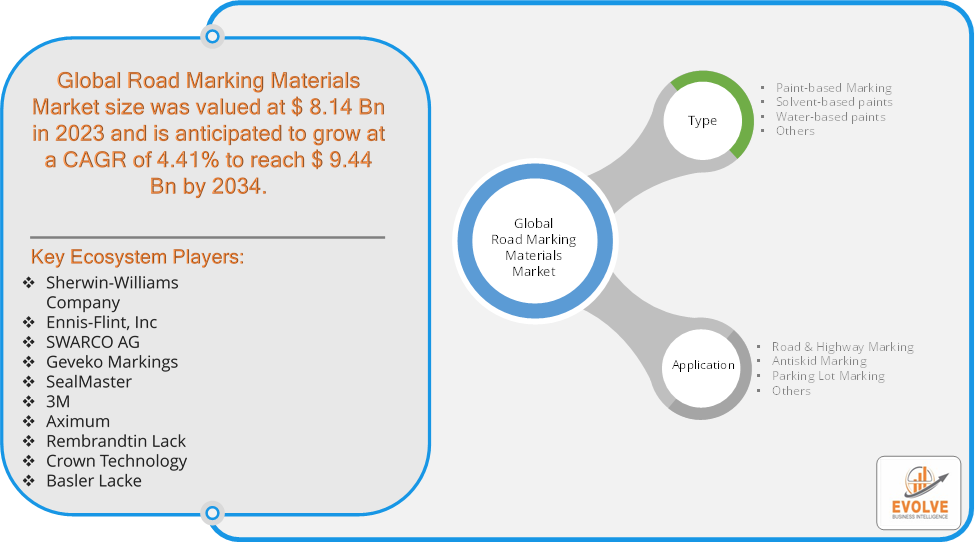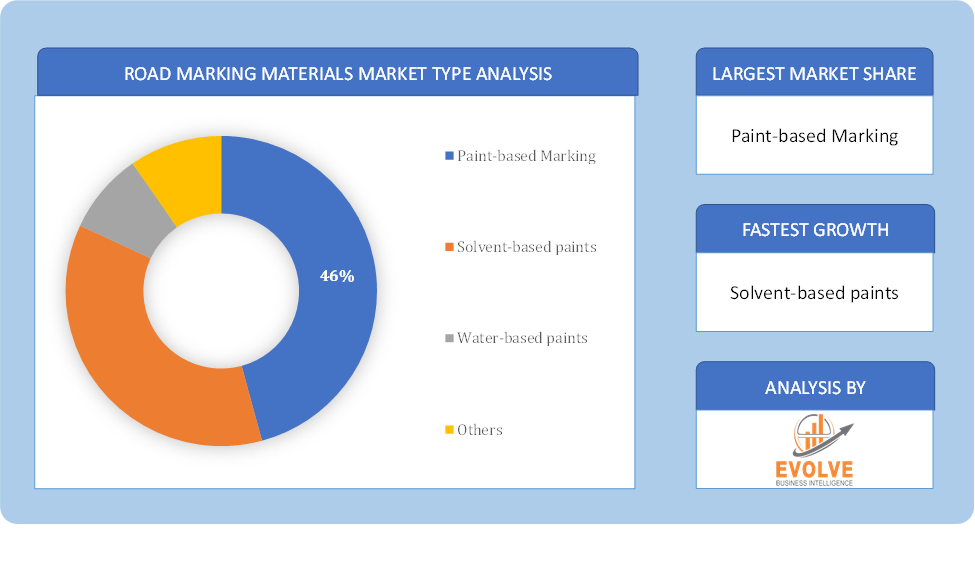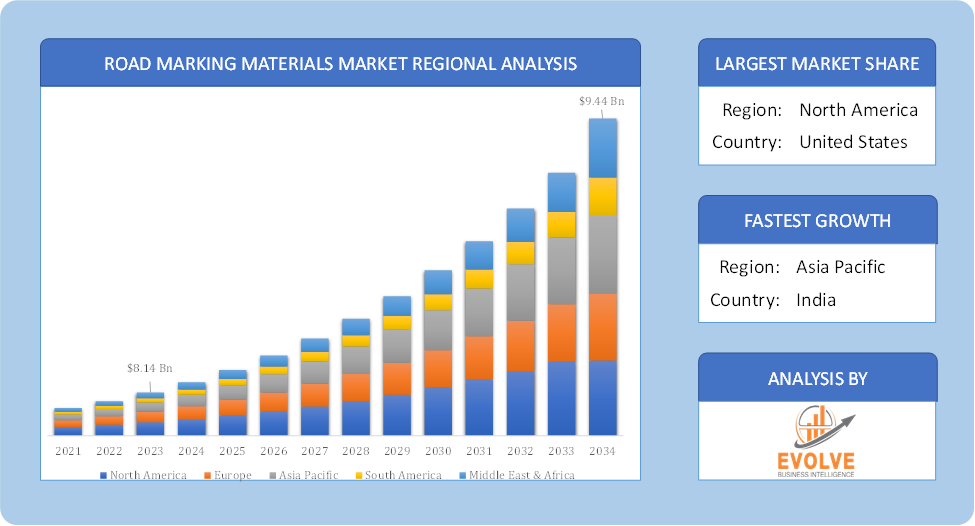Road Marking Materials Market Analysis and Global Forecast 2024-2034
$ 1,390.00 – $ 5,520.00Price range: $ 1,390.00 through $ 5,520.00
Road Marking Materials Market Research Report: Information By Type (Paint-based Marking, Solvent-based paints, Water-based paints, Others), By Application (Road & Highway Marking, Antiskid Marking, Parking Lot Marking, Others), and by Region — Forecast till 2034
Page: 125
Road Marking Materials Market Overview
The Road Marking Materials Market size accounted for USD 8.14 Billion in 2023 and is estimated to account for 8.74 Billion in 2024. The Market is expected to reach USD 9.44 Billion by 2034 growing at a compound annual growth rate (CAGR) of 4.41% from 2024 to 2034. The Road Marking Materials Market focuses on products used for marking streets, roads, highways, and other surfaces to improve safety, provide guidance, and ensure traffic flow. These materials are essential for demarcating lanes, pedestrian crossings, parking zones, and other areas of traffic management.
The road marking materials market is a vital component of the transportation infrastructure industry, ensuring safety and efficiency on roads worldwide.
Global Road Marking Materials Market Synopsis
 Road Marking Materials Market Dynamics
Road Marking Materials Market Dynamics
The major factors that have impacted the growth of Road Marking Materials Market are as follows:
Drivers:
Ø Technological Advancements
The development of durable, weather-resistant, and highly reflective road marking materials is gaining traction. Technologies like thermoplastics, cold plastic materials, and reflective glass beads are becoming more popular due to their superior performance and longer lifespan. The integration of automation technologies in the road marking process, such as machine-controlled painting systems, enhances accuracy and efficiency in applying road markings, increasing the use of high-quality materials. Road markings are exposed to extreme weather conditions, heavy traffic, and wear over time, creating a demand for materials that are durable and can withstand harsh environments, such as thermoplastic and cold plastic road marking products.
Restraint:
- Perception of Fluctuating Raw Material Prices and High Cost of Alternatives
The prices of raw materials used in road marking materials, such as resins, pigments, and solvents, are volatile. Fluctuations in the cost of these inputs can directly impact the overall production cost of road marking materials, making them less affordable for end-users. Many road marking materials, particularly thermoplastic and solvent-based paints, rely on petroleum-based components. Rising crude oil prices can lead to increased manufacturing costs. While eco-friendly materials like water-based paints and durable thermoplastics are gaining popularity, their initial costs are higher than traditional materials. This can be a barrier for smaller municipal corporations or regions with limited budgets, which may opt for cheaper but less durable solutions.
Opportunity:
⮚ Focus on Road Safety and Traffic Management
Governments are increasingly focusing on reducing traffic accidents and improving road safety. Advanced road markings, such as highly reflective materials and luminescent paints that enhance nighttime visibility, offer significant opportunities to improve safety in urban and rural areas. The rise of autonomous vehicles presents opportunities for the development of smart road markings. Markings embedded with sensors or designed to be easily detected by autonomous driving systems will be crucial for future traffic management systems. As smart transportation systems become more widespread, road markings that can integrate with V2I communication technologies offer new opportunities. Markings that work with sensors or are embedded with data-carrying technologies could assist autonomous vehicles in navigation and lane management.
Road Marking Materials Market Segment Overview
Based on Type, the market is segmented based on Paint-based Marking, Solvent-based paints, Water-based paints and Others. The water-based coatings segment dominant the market due to its environment-friendly nature. Further, these paints support energy conservation and sustainability and hence are widely employed in construction and infrastructures. Conventional paints are used for painting signs and boards in public spaces.
By Application
Based on Application, the market has been divided into Road & Highway Marking, Antiskid Marking, Parking Lot Marking and Others. The roads & highway segment dominant the market. The growing demand for water-borne thermoplastic coatings for protecting the retro-reflectivity markings on roads and parking spaces/lots is one of the prime factors driving the market. Besides, the increasing demand for water-proof coatings from multiple application areas including airports, malls, parking lots of malls, shopping centers, housing societies, and others is also expected to drive the market’s growth.
Global Road Marking Materials Market Regional Analysis
Based on region, the global Road Marking Materials Market has been divided into North America, Europe, Asia-Pacific, the Middle East & Africa, and Latin America. North America is projected to dominate the use of the Road Marking Materials Market followed by the Asia-Pacific and Europe regions.
 Road Marking Materials North America Market
Road Marking Materials North America Market
North America holds a dominant position in the Road Marking Materials Market. North America, particularly the U.S. and Canada, has a well-developed road infrastructure, driving demand for maintenance and refurbishment of existing roads. The region has stringent road safety regulations and advanced road marking standards. Strong focus on road safety and the adoption of advanced technologies and increasing use of smart transportation systems and autonomous vehicle technologies, requiring precise road markings.
Road Marking Materials Asia-Pacific Market
The Asia-Pacific region has indeed emerged as the fastest-growing market for the Road Marking Materials Market industry. Asia-Pacific is expected to be the fastest-growing region, driven by rapid urbanization and infrastructure development in countries like China, India, and Southeast Asia. Rising vehicle ownership and traffic density, leading to increased demand for road markings to manage traffic and improve safety and growing demand for durable and weather-resistant road marking materials due to diverse and often extreme climate conditions in the region.
Competitive Landscape
The global Road Marking Materials Market is highly competitive, with numerous players offering a wide range of software solutions. The competitive landscape is characterized by the presence of established companies, as well as emerging startups and niche players. To increase their market position and attract a wide consumer base, the businesses are employing various strategies, such as product launches, and strategic alliances.
Prominent Players:
- Sherwin-Williams Company
- Ennis-Flint, Inc
- SWARCO AG
- Geveko Markings
- SealMaster
- 3M
- Aximum
- Rembrandtin Lack
- Crown Technology
- Basler Lacke
Key Development
In January 2022, Geveko Markings expanded into France by acquiring Oré Peinture. This move expanded Geveko Markings’ operational reach and enhanced its assets and production capacity in the French market.
Scope of the Report
Global Road Marking Materials Market, by Type
- Paint-based Marking
- Solvent-based paints
- Water-based paints
- Others
Global Road Marking Materials Market, by Application
- Road & Highway Marking
- Antiskid Marking
- Parking Lot Marking
- Others
Global Road Marking Materials Market, by Region
- North America
- US
- Canada
- Mexico
- Europe
- UK
- Germany
- France
- Italy
- Spain
- Benelux
- Nordic
- Rest of Europe
- Asia Pacific
- China
- Japan
- South Korea
- Indonesia
- Austalia
- Malaysia
- India
- Rest of Asia Pacific
- South America
- Brazil
- Argentina
- Rest of South America
- Middle East & Africa
- Saudi Arabia
- UAE
- Egypt
- South Africa
- Rest of Middle East & Africa
| Parameters | Indicators |
|---|---|
| Market Size | 2033: USD 9.44 Billion |
| CAGR (2024-2034) | 4.41% |
| Base year | 2022 |
| Forecast Period | 2024-2034 |
| Historical Data | 2021 (2017 to 2020 On Demand) |
| Report Coverage | Revenue Forecast, Competitive Landscape, Growth Factors, and Trends |
| Key Segmentations | Type, Application |
| Geographies Covered | North America, Europe, Asia-Pacific, South America, Middle East, Africa |
| Key Vendors | Sherwin-Williams Company, Ennis-Flint, Inc, SWARCO AG, Geveko Markings, SealMaster, 3M, Aximum, Rembrandtin Lack, Crown Technology and Basler Lacke |
| Key Market Opportunities | · Focus on Road Safety and Traffic Management
· Rising Adoption of Smart Transportation Systems |
| Key Market Drivers | · Technological Advancements
· Rising Demand for Durable Road Markings |
REPORT CONTENT BRIEF:
- High-level analysis of the current and future Road Marking Materials Market trends and opportunities
- Detailed analysis of current market drivers, restraining factors, and opportunities in the future
- Road Marking Materials Market historical market size for the year 2021, and forecast from 2023 to 2033
- Road Marking Materials Market share analysis at each product level
- Competitor analysis with detailed insight into its product segment, Government & Defense strength, and strategies adopted.
- Identifies key strategies adopted including product launches and developments, mergers and acquisitions, joint ventures, collaborations, and partnerships as well as funding taken and investment done, among others.
- To identify and understand the various factors involved in the global Road Marking Materials Market affected by the pandemic
- To provide a detailed insight into the major companies operating in the market. The profiling will include the Government & Defense health of the company’s past 2-3 years with segmental and regional revenue breakup, product offering, recent developments, SWOT analysis, and key strategies.
Frequently Asked Questions (FAQ)
What is the study period of this market?
The study period of the global Road Marking Materials Market is 2021- 2033
What is the growth rate of the global Road Marking Materials Market?
The global Road Marking Materials Market is growing at a CAGR of 4.41% over the next 10 years
Which region has the highest growth rate in the market of Road Marking Materials Market?
Asia Pacific is expected to register the highest CAGR during 2024-2034
Which region has the largest share of the global Road Marking Materials Market?
North America holds the largest share in 2022
Who are the key players in the global Road Marking Materials Market?
Sherwin-Williams Company, Ennis-Flint, Inc, SWARCO AG, Geveko Markings, SealMaster, 3M, Aximum, Rembrandtin Lack, Crown Technology and Basler Lacke are the major companies operating in the market.
Do you offer Post Sale Support?
Yes, we offer 16 hours of analyst support to solve the queries
Do you sell particular sections of a report?
Yes, we provide regional as well as country-level reports. Other than this we also provide a sectional report. Please get in contact with our sales representatives.
Press Release

Global Pharmaceutical Manufacturing Market to Reach $1.38 Trillion by 2035 with 7.35% CAGR, New Research Shows

The Global Mammography Market Is Estimated To Record a CAGR of Around 10.29% During The Forecast Period

Glue Stick Market to Reach USD 2.35 Billion by 2034

Podiatry Service Market to Reach USD 11.88 Billion by 2034

Microfluidics Technology Market to Reach USD 32.58 Billion by 2034

Ferric Chloride Market to Reach USD 10.65 Billion by 2034

Family Practice EMR Software Market to Reach USD 21.52 Billion by 2034

Electric Hairbrush Market to Reach USD 15.95 Billion by 2034

Daily Bamboo Products Market to Reach USD 143.52 Billion by 2034

Cross-border E-commerce Logistics Market to Reach USD 112.65 Billion by 2034
Table of Content
Chapter 1. Executive Summary Chapter 2. Scope Of The Study 2.1. Market Definition 2.2. Scope Of The Study 2.2.1. Objectives of Report 2.2.2. Limitations 2.3. Market Structure Chapter 3. Evolve BI Methodology Chapter 4. Market Insights and Trends 4.1. Supply/ Value Chain Analysis 4.1.1. Raw End Users Providers 4.1.2. Manufacturing Process 4.1.3. Distributors/Retailers 4.1.4. End-Use Industry 4.2. Porter’s Five Forces Analysis 4.2.1. Threat Of New Entrants 4.2.2. Bargaining Power Of Buyers 4.2.3. Bargaining Power Of Suppliers 4.2.4. Threat Of Substitutes 4.2.5. Industry Rivalry 4.3. Impact Of COVID-19 on the Road Marking Materials Market 4.3.1. Impact on Market Size 4.3.2. End-Use Industry Trend, Preferences, and Budget Impact 4.3.3. Regulatory Framework/Government Policies 4.3.4. Key Players' Strategy to Tackle Negative Impact 4.3.5. Opportunity Window 4.4. Technology Overview 12.28. Macro factor 4.6. Micro Factor 4.7. Demand Supply Gap Analysis of the Road Marking Materials Market 4.8. Import Analysis of the Road Marking Materials Market 4.9. Export Analysis of the Road Marking Materials Market Chapter 5. Market Dynamics 5.1. Introduction 5.2. DROC Analysis 5.2.1. Drivers 5.2.2. Restraints 5.2.3. Opportunities 5.2.4. Challenges 5.3. Patent Analysis 5.4. Industry Roadmap 5.5. Parent/Peer Market Analysis Chapter 6. Global Road Marking Materials Market, By Product Type 6.1. Introduction 6.2. Paint-based Marking 6.3. Solvent-based paints 6.4. Water-based paints 6.5. Others Chapter 7. Global Road Marking Materials Market, By Application 7.1. Introduction 7.2. Road & Highway Marking 7.3. Antiskid Marking 7.4. Parking Lot Marking 7.5. Others Chapter 8. Global Road Marking Materials Market, By Region 8.1. Introduction 8.2. North America 8.2.1. Introduction 8.2.2. Driving Factors, Opportunity Analyzed, and Key Trends 8.2.3. Market Size and Forecast, By Country, 2024-2034 8.2.4. Market Size and Forecast, By Product Type, 2024-2034 8.2.5. Market Size and Forecast, By End User, 2024-2034 8.2.6. US 8.2.6.1. Introduction 8.2.6.2. Driving Factors, Opportunity Analyzed, and Key Trends 8.2.6.3. Market Size and Forecast, By Product Type, 2024-2034 8.2.6.4. Market Size and Forecast, By End User, 2024-2034 8.2.7. Canada 8.2.7.1. Introduction 8.2.7.2. Driving Factors, Opportunity Analyzed, and Key Trends 8.2.7.4. Market Size and Forecast, By Product Type, 2024-2034 8.2.7.5. Market Size and Forecast, By End User, 2024-2034 8.3. Europe 8.3.1. Introduction 8.3.2. Driving Factors, Opportunity Analyzed, and Key Trends 8.3.3. Market Size and Forecast, By Country, 2024-2034 8.3.4. Market Size and Forecast, By Product Type, 2024-2034 8.3.5. Market Size and Forecast, By End User, 2024-2034 8.3.6. Germany 8.3.6.1. Introduction 8.3.6.2. Driving Factors, Opportunity Analyzed, and Key Trends 8.3.6.3. Market Size and Forecast, By Product Type, 2024-2034 8.3.6.4. Market Size and Forecast, By End User, 2024-2034 8.3.7. France 8.3.7.1. Introduction 8.3.7.2. Driving Factors, Opportunity Analyzed, and Key Trends 8.3.7.3. Market Size and Forecast, By Product Type, 2024-2034 8.3.7.4. Market Size and Forecast, By End User, 2024-2034 8.3.8. UK 8.3.8.1. Introduction 8.3.8.2. Driving Factors, Opportunity Analyzed, and Key Trends 8.3.8.3. Market Size and Forecast, By Product Type, 2024-2034 8.3.8.4. Market Size and Forecast, By End User, 2024-2034 8.3.9. Italy 8.3.9.1. Introduction 8.3.9.2. Driving Factors, Opportunity Analyzed, and Key Trends 8.3.9.3. Market Size and Forecast, By Product Type, 2024-2034 8.3.9.4. Market Size and Forecast, By End User, 2024-2034 8.3.11. Rest Of Europe 8.3.11.1. Introduction 8.3.11.2. Driving Factors, Opportunity Analyzed, and Key Trends 8.3.11.3. Market Size and Forecast, By Product Type, 2024-2034 8.3.11.4. Market Size and Forecast, By End User, 2024-2034 8.4. Asia-Pacific 8.4.1. Introduction 8.4.2. Driving Factors, Opportunity Analyzed, and Key Trends 8.4.3. Market Size and Forecast, By Country, 2024-2034 8.4.4. Market Size and Forecast, By Product Type, 2024-2034 8.12.28. Market Size and Forecast, By End User, 2024-2034 8.4.6. China 8.4.6.1. Introduction 8.4.6.2. Driving Factors, Opportunity Analyzed, and Key Trends 8.4.6.3. Market Size and Forecast, By Product Type, 2024-2034 8.4.6.4. Market Size and Forecast, By End User, 2024-2034 8.4.7. India 8.4.7.1. Introduction 8.4.7.2. Driving Factors, Opportunity Analyzed, and Key Trends 8.4.7.3. Market Size and Forecast, By Product Type, 2024-2034 8.4.7.4. Market Size and Forecast, By End User, 2024-2034 8.4.8. Japan 8.4.8.1. Introduction 8.4.8.2. Driving Factors, Opportunity Analyzed, and Key Trends 8.4.8.3. Market Size and Forecast, By Product Type, 2024-2034 8.4.8.4. Market Size and Forecast, By End User, 2024-2034 8.4.9. South Korea 8.4.9.1. Introduction 8.4.9.2. Driving Factors, Opportunity Analyzed, and Key Trends 8.4.9.3. Market Size and Forecast, By Product Type, 2024-2034 8.4.9.4. Market Size and Forecast, By End User, 2024-2034 8.4.10. Rest Of Asia-Pacific 8.4.10.1. Introduction 8.4.10.2. Driving Factors, Opportunity Analyzed, and Key Trends 8.4.10.3. Market Size and Forecast, By Product Type, 2024-2034 8.4.10.4. Market Size and Forecast, By End User, 2024-2034 8.5. Rest Of The World (RoW) 8.5.1. Introduction 8.5.2. Driving Factors, Opportunity Analyzed, and Key Trends 8.5.3. Market Size and Forecast, By Product Type, 2024-2034 8.5.4. Market Size and Forecast, By End User, 2024-2034 Chapter 9. Company Landscape 9.1. Introduction 9.2. Vendor Share Analysis 9.3. Key Development Analysis 9.4. Competitor Dashboard Chapter 10. Company Profiles 10.1. Sherwin-Williams Company 10.1.1. Business Overview 10.1.2. Government & Defense Analysis 10.1.2.1. Government & Defense – Existing/Funding 10.1.3. Product Portfolio 10.1.4. Recent Development and Strategies Adopted 10.1.5. SWOT Analysis 10.2. Ennis-Flint Inc 10.2.1. Business Overview 10.2.2. Government & Defense Analysis 10.2.2.1. Government & Defense – Existing/Funding 10.2.3. Product Portfolio 10.2.4. Recent Development and Strategies Adopted 10.2.5. SWOT Analysis 10.3. SWARCO AG 10.3.1. Business Overview 10.3.2. Government & Defense Analysis 10.3.2.1. Government & Defense – Existing/Funding 10.3.3. Product Portfolio 10.3.4. Recent Development and Strategies Adopted 10.3.5. SWOT Analysis 10.4. Geveko Markings 10.4.1. Business Overview 10.4.2. Government & Defense Analysis 10.4.2.1. Government & Defense – Existing/Funding 10.4.3. Product Portfolio 10.4.4. Recent Development and Strategies Adopted 10.12.28. SWOT Analysis 10.5. SealMaster 10.5.1. Business Overview 10.5.2. Government & Defense Analysis 10.5.2.1. Government & Defense – Existing/Funding 10.5.3. Product Portfolio 10.5.4. Recent Development and Strategies Adopted 10.5.5. SWOT Analysis 10.6. 3M 10.6.1. Business Overview 10.6.2. Government & Defense Analysis 10.6.2.1. Government & Defense – Existing/Funding 10.6.3. Product Portfolio 10.6.4. Recent Development and Strategies Adopted 10.6.5. SWOT Analysis 10.7. Aximum 10.7.1. Business Overview 10.7.2. Government & Defense Analysis 10.7.2.1. Government & Defense – Existing/Funding 10.7.3. Product Portfolio 10.7.4. Recent Development and Strategies Adopted 10.7.5. SWOT Analysis 10.8 Rembrandtin Lack 10.8.1. Business Overview 10.8.2. Government & Defense Analysis 10.8.2.1. Government & Defense – Existing/Funding 10.8.3. Product Portfolio 10.8.4. Recent Development and Strategies Adopted 10.8.5. SWOT Analysis 10.9 Crown Technology 10.9.1. Business Overview 10.9.2. Government & Defense Analysis 10.9.2.1. Government & Defense – Existing/Funding 10.9.3. Product Portfolio 10.9.4. Recent Development and Strategies Adopted 10.9.5. SWOT Analysis 10.10. Basler Lacke 10.10.1. Business Overview 10.10.2. Government & Defense Analysis 10.10.2.1. Government & Defense – Existing/Funding 10.10.3. Product Portfolio 10.10.4. Recent Development and Strategies Adopted 10.10.5. SWOT Analysis
Connect to Analyst
Research Methodology








